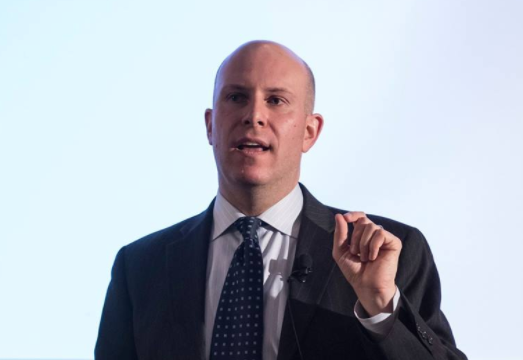Nathaniel Stinnett knows he’s preaching to the choir. The problem is, even believers don’t always show up for church.
Dismayed by how low environmental concerns like climate change, pollution and pipelines rank on surveys of voter priorities, Stinnett founded the nonpartisan Environmental Voter Project three years ago on the hunch that a substantial number of people care about environmental issues and are registered to vote, but don’t show up on Election Day.
The veteran Boston-based campaign strategist developed a formula for identifying these voters. He builds profiles based on consumer demographic and behavioral data, then runs a series of polls to verify the data and find out how likely voters are to list environmental causes among their top two political priorities. Stinnett and his team of three sift through the survey reponses to identify patterns.
After that, they run those profiles through a model that scores voters based on how likely they are to be so-called “super environmentalists.” Finally, they cut out people whose public voting records show they turn out for most elections.
What’s left is a group of registered voters who don’t need to be sold on the reality of climate change or the dangers of air pollution ― they just need to be convinced to get to the polls.
“We’re laser-focused on creating an army of environmental super voters who will drive the agenda at the local, state and federal levels,” Stinnett told HuffPost. “Driving all of these environmentalists into the electorate is going to have an enormous impact on policy-making.”

Stinnett put his system to the test in a Boston city council election in November 2015, targeting roughly 25,000 voters he had identified as likely to list environmental issues as a top concern, but unlikely to cast a ballot.
He set aside a small control group and hit the rest of the nonvoters with the full treatment ― door-to-door canvassing, digital ads, mailers, emails, texts and phone-bank calls. He saw a 4.8 percent increase in turnout compared to the control group.
Four months later, he did the same thing with a group of around 70,000 voters in Boston and its surrounding suburbs. Turnout in that group increased 5.1 percent compared to the control group.
Then came the big test ― last November’s presidential election. His three-person team targeted 150,000 voters across the entire state of Massachusetts. They found a 4.7 percent bump in turnout among targeted voters compared to those who didn’t receive the canvassing.
“That’s the one we’re most proud of,” Stinnett said. “People who don’t vote in presidential elections pretty much don’t vote in anything.”
The Environmental Voter Project expanded its work to Georgia earlier this year for the closely-watched special election for the state’s 6th District. It has yet to fully quantify its efforts there, but is already planning to expand to other states.
The group now plans to launch in Colorado, Florida, Nevada and Pennsylvania, where it has identified 2.4 million “non-voting super environmentalists.” All four states are likely to be key battlegrounds in the 2018 midterm and gubernatorial elections, but Stinnett’s goal isn’t to secure victories for specific candidates.
“We’re not an election-winning organization, we’re an electorate-changing organization,” he said.
In that sense, Stinnett’s most critical metric of success comes from the roughly 15,000 voters targeted in every election in Massachusetts since the Environmental Voter Project began nearly two years ago. Compared to the control group, those voters turned out at a 12.1 percent higher rate across all of the elections combined.
“We’re not an election-winning organization, we’re an electorate-changing organization.”
- Nathaniel Stinnett, chief executive of the Environmental Voter Project
“We want them to vote as often as NRA members do,” Stinnett said, referring to the National Rifle Association’s record of registering its members to vote and mobilizing them to cast their ballots for certain candidates, who tend to win after receiving NRA support. “Environmental voters have the potential to overwhelm the electorate.”
The NRA only spends about $3 million a year on lobbying, but the group spurs its members to be politically active. In one study cited by The New Yorker, gun rights supporters were four times more likely to have donated money or written to a politician than people who favored stricter permits on guns. The Environmental Voter Project, by contrast, depends on fastidiously tested data and old-fashioned peer pressure.
While the group focuses on people who have demonstrated sympathies for the environmental movement, its get-out-the-vote materials barely mention the environment. The Environmental Voter Project’s name makes clear what it stands for, but Stinnett focuses instead on the need to vote in mailers, emails and scripts provided to phone bank volunteers. The group tests its messaging as rigorously as it does its targets.
“Even people who never vote still buy into the societal norm that voting is a good thing,” Stinnett said.
The pitch usually goes something like this: “Did you know the last time there was a city council election, 93 people on your block of Main Street voted? Whether you vote or not is public record. There’s an election Tuesday, and we know it’s important for you to be a good voter. We’ll follow up after the election to see how your experience was at the polls.”
“I’m not ashamed to admit that we use shame,” Stinnett said. “I readily admit that that’s a little aggressive, but it works.”
Stinnett’s initial success has attracted ardent supporters. Charlie Baker III, the former chief administrative officer of Hillary Clinton’s presidential campaign, became an early donor.
“In the last cycle, they meaningfully increased turnout,” Baker, president and co-founder of the strategy firm Dewey Square Group, told HuffPost. “One of the hardest things to do is to get people who don’t normally vote to vote. And they’re tackling the toughest of the toughest in terms of people who passionately care about the environment but don’t have a solid voting history.”

The Environmental Voter Project has advanced with very little funding. It raised $400,000 through online crowdfunding ahead of its launch, and another $1.1 million from 1,509 individual contributions in the last two years.
The largest donations came from billionaire investor Jeremy Grantham, who has recently focused his philanthropy on “trying to buy time for the world to wake up” to climate change. The projected combined budget for 2017 and 2018 is $2 million, though Stinnett said that could increase if donations continue to grow.
“We had to revise twice in the last five to six months because we’re getting good results and people are increasingly excited about what we’re doing,” he said.
That may sound like a lot, but compared to other nonprofits doing similar work, it amounts to peanuts. The League of Conservation Voters raised nearly $11.5 million in 2015 and spent $45 million on the 2016 election. Earthjustice, which doesn’t spend on elections, had a 2017 budget of about $51.5 million.
For Sambhav Sankar, a senior technology adviser at The Nature Conservancy, donating to the Environmental Voter Project felt like investing in “a durable movement” with a longer outlook than most other green advocacy groups.
“All of them chase the next election or the next six months, but don’t know how to think about this long term,” Sankar told HuffPost. “This guy is doing exactly the opposite.”
Despite how counterintuitive the Environmental Voter Project’s model may be in environmental politics, Stinnett argues for its mission with simple logic.
“We’ve already won the battle for the hearts and minds. Now we just need to do the easiest thing and take 20 minutes out of our day once or twice a year and vote,” Stinnett said. “It’s a heck of a lot easier than getting a climate skeptic to change his or her mind.”

